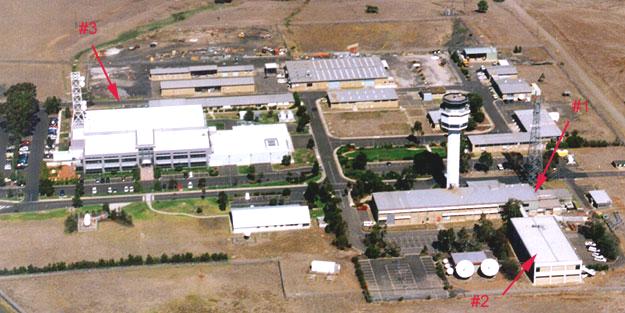
This photograph, taken on 5 April 2003 and looking slightly east of south, shows
the locations of Melbourne Airport's three Air Traffic Control Centres. Melbourne
Control Tower can also be clearly seen, as can various communication masts and
sattellite dishes which provide links to radar and communications equipment sited
throughout Australia. The Terminal is located on the other side of the main north-south
runway, out of shot to the left.
The first Area Approach Control Centre (AACC) at Melbourne's then-new Tullamarine Airport was commissioned on 20 September 1967, some time before the airport itself commenced operations. The equipment used was the Bright Display system, fed by Thompson-CSF radar equipment. Prior to the opening of the AACC the radar controllers actually operated out of the radar hut on Radar Hill, located at the north-western side of the airport. Earlier AACCs were located at the old Essendon Airport.
AACC #1 itself was located on the upper floor at the western end of Building 4. Adjacent was the Melbourne Flight Service Centre. A Training Annexe was housed in the opposite end of the building and in May 1981 a new Bright Display radar simulator was installed. The lower floor of the building contained all the electronics and switching equipment for the radars and communications.
AACC #2 was at least twice the size of #1 and was built to accomodate the new ATCARDS radar display system. It was commissioned operationally in November 1988. Once again, the AACC was located on the upper floor whilst the electronics were located below. Although the AACC was originally quite spacious (carpet bowls was a popular Sunday morning passtime in the early years), the programme of consolidation of other Centres into Melbourne meant that by the end the 1990s it was somewhat over-crowded. An ATCARDS simulator was also installed in the Training Annexe, commencing use in 1989.
The transition to the computerised TAAATS system, commencing in December 1999, and the consolidation of the Flight Service function to Air Traffic Control, brought with it a new Air Traffic Services Centre (ATSC) in a new building. In addition to the ATSC on the upper floor, the building also houses a simulator, classrooms, offices, equipment rooms and a canteen.
(Photo: Phil Vabre collection)
Back to the main Air Traffic Services index